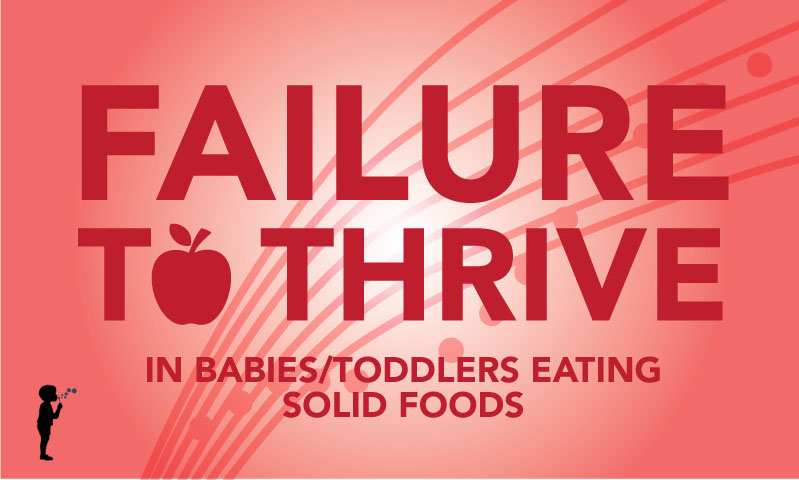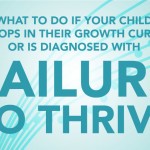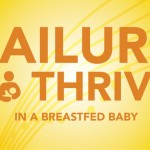
Failure to Thrive in Babies/Toddlers Eating Solid Foods
If your baby has failure to thrive please read the first part of this blog post at: What to do if your child drops on their growth curve or is diagnosed with Failure to Thrive
Is it normal?
First I want to say that dips on the growth curve are extremely common in exclusively breastfed babies who are transitioning to solids, especially around the 9-12 month mark. It isn’t uncommon for babies this age to have some difficulty wrapping their heads (or mouths) around the fact that they need to start putting some effort into eating. Some have issues with textures, tastes or smells and others struggle with not having enough teeth to chew correctly. Babies at this age also become highly distracted at the breast, and as they crawl and walk start to burn calories very quickly. Many, many times these babies finally “get it” and start eating well around 12 months and come back up on the growth curve without much intervention at all. Again – refer to the World Health Organization (WHO) growth chart rather than CDC growth chart, as it more accurately reflects the normal “dip” at 9-12 months.
Also, for exclusively breastfed & transitioning babies – it can be very challenging for Moms to get enough calories to sustain breastmilk production for these rapidly growing (and large!) babies. Unfortunately many Moms start to have drops in breastmilk production, or simply cannot increase their production enough to make up for the amount of calories a baby needs as he grows. I also see many Moms who are exhausted around the 9 month mark – self-care starts to slide, the months of sleep deprivation finally catch up, and the demands of a highly mobile baby are extremely wearing. Take care of yourself!
Simple tricks for increasing calories
I always recommend parents to first start with the simple tricks for increasing calories to help weight gain in their transitioning babies.
First: focus on high-protein and high-fat foods. Unfortunately most jarred baby foods are high in sweets and starches (carbohydrates). This makes the food taste good, but does little to increase calories. Remember that if a child is eating 4 oz of jarred baby food rather than drinking 4 oz of breastmilk (or formula) the child is actually running a calorie deficit unless more calories are added elsewhere. Breastmilk and formula are naturally more calorie-dense than nearly all jarred baby food.
You can easily add more fat to jarred baby foods by adding 1/2-1 teaspoon of olive oil, flax seed oil or ghee to each container of baby food. The same holds if you are making your own solid foods. (Coconut oil is another great option, but tends to solidify unless the food is somewhat warm, which can make it a challenge to mix in. Also be aware the coconut is a somewhat common allergen/intolerance food, so if your child is showing signs of allergies/food intolerances please notify your physician and stop the coconut oil right away).
For older children focus on high-calorie protein-containing foods like cheese (if dairy tolerant), nut butters, meats, eggs, or bean dips mixed with fat (e.g., hummus with olive oil). Continue to offer vegetables even if they are not a large source of calories – they contain essential nutrients that help growth. Just make sure that low-calorie vegetables are not the only source of food, they need to be balanced with high calorie, high protein foods. Increase calories of meals by drizzling olive oil or sprinkling cheese over foods. Avocado is high in healthy fats and is a wonderful addition to sandwiches.
Also consider adding calories in liquid form by making smoothies. Here is Dr. Erika’s most commonly requested smoothie recipe:
- 1 cup frozen berries (slightly thawed if it is too cold)
- 2-4 tablespoons of protein powder (whey if dairy tolerant, otherwise I commonly recommend rice protein powder for the sensitive patients in my practice)
- 1 tablespoon of flax seed oil (~120 calories in one tablespoon)
- Small amount of spinach or kale (1/2 a handful or less) – for increased minerals
- Almond milk (or regular milk) – enough to cover the berries.
Blend and enjoy. You can increase calories further by adding a few tablespoons of coconut milk ice cream. This smoothie can be 400-500 calories for 12-16 ounces when prepared correctly.
There are other high-calorie milkshake recipes on the internet – here is a source from Golisano Children’s Hospital.
I typically do NOT recommend commercial products like PediaSure®, unless that is truly the only option (for financial reasons, etc). PediaSure® is high in sugar, contains vitamins that are not in a form that is bioavailable (see LINK), and also contain food dyes. It is always a better idea to provide children with real, whole foods whenever possible. Check out these links articles on natural alternatives to PediaSure®.
Is there a natural alternative to PediaSure?
G-tubes, PediaSure®, and Pureed Whole Foods
A note about food intolerances
Food sensitivities/intolerances can be really, really tough to deal with in a child with failure to thrive. First I want to say please do NOT restrict foods in your failure to thrive child unless you are absolutely sure your child has an allergy/intolerance. There have been MANY instances where I have seen parents who are limiting foods based on an incorrect belief that their child is “sensitive” to that food.
See this guide on how to do a CORRECT food elimination/challenge diet. I recommend limiting only 1 food at a time unless your physician tells you otherwise.
Again, navigating food sensitivities can be extremely tricky in failure-to-thrive children. Please speak with your doctor and manage your child’s diet carefully. Some children may improve remarkably on a low-allergen diet where others may struggle when food choices are further limited.
If your child is TRULY intolerant of foods you may be able to find some high calorie substitutes. Try sheep or goat milk cheese for cow’s dairy intolerant children. You can also try duck or quail eggs for children who cannot handle chicken eggs. Nut butters may be replaced with seed butters like Sunbutter.
Iron, zinc and calcium
Children who are dropping on the growth curve will often need additional iron, zinc and calcium to help speed growth. Be sure your provider screens your child for iron-deficiency anemia, as this can contribute to failure to thrive AND difficulties eating. I also recommend screening for vitamin D deficiency if you are in a northern area or place with limited sun exposure.
I always recommend introducing iron-containing foods early. I usually recommend some type of iron-containing food to be introduced within the first 2 weeks of solids as long as the baby is tolerating solid foods well. Free range beef, organic chicken, wild game (abundant here in Montana, I know it can be hard in other places of the country), or vegetarian iron-containing foods are great. Heme iron is the type of iron that is found in meats and is the most easily absorbed; for non-vegetarian/vegan families I usually recommend meats early. (Speak to your doctor if your family is vegan or vegetarian so your child can catch up on some of the nutrients that are typically found in meats – things like choline, vitamin B12, etc.) See this article for more information on iron-containing foods.
Limit low calorie foods, avoid excessive snacking
It may seem counterintuitive, but I always recommend children to avoid frequent snacking throughout the day. Frequent snacking means the child never really experiences hunger, and will often consume small amounts of low calorie foods. Aim for 3 meals per day with two to three snacks per day. Do not give snacks immediately after an unfinished meal.
Do not give children fruit juices. This is because juice can “fill” the stomach and trigger satiety (the sensation of being full) without the child actually consuming a meal. Additionally, fruit juices are relatively low in calories, and are very low in actual nutrients. Fruit juice that contains sorbitol can also cause osmotic diarrhea (See our Treatment for Children’s Constipation without Miralax blog post), which can lead to further loss of nutrients.
Do NOT increase calories by giving the child junk food like chips, cookies, soda, or dry cereal. These foods are actually relatively low in calories and have very few, if any, nutrients that help growth. It also creates bad habits which can be extremely hard to break as the child gets older.
Have a healthy, calm mealtime environment
Aim for keeping mealtimes and snack times consistent from day to day. This is very important because our bodies normally keep a circadian rhythm that “tells” us when to be hungry and eat. Keep mealtimes relatively short (less than 20 minutes for a toddler) to avoid frustrating the child.
Keep mealtimes peaceful and pleasant. Turn off TV’s, tablets and phones. Aim for family meals so the child can watch others eat and interact with food in a positive manner. Make sure the child is positioned properly so she can reach food and is at eye level with the rest of the family (e.g., high chair or booster seat).
Remember that parents are responsible for providing healthy foods at an appropriate time; children are responsible for deciding how much to eat. Do not force a child to eat. It may be helpful to have the child eat very small bites (samples) of food first before working up to bigger meals. Keep every interaction with food positive and stop the meal if the child gets angry or frustrated. (It’s okay to try again later!)
Most importantly – NEVER use food as a punishment. ALWAYS heavily praise and use positive reinforcement, even for the tiniest of improvement.
Try Baby Led Weaning
Some babies just really need to feed themselves. It is normal and natural for a child to want to be engaged in their food. Give your baby a spoon and let him feed himself! In between self-fed bites you can often sneak in another spoonful.
Some children also prefer to skip purees altogether (as in true Baby Led Weaning). Baby Led Weaning can make feeding time feel more like “play,” which can help children who are struggling consuming solids. Be careful, however, that the child truly consumes calories and doesn’t just play with his food. While the child is having fun you can often encourage the child to eat more by sneaking in a bite right into their mouth.
Also: remember that messes are normal – do not restrict or limit food just because you fear a mess. If you are exhausted from cleaning try putting saran wrap over the high chair tray and a towel on the floor for easy clean-up.
Baby Led Weaning is probably not appropriate for children with severe failure to thrive or for babies/toddlers who lack the skills to be able to feed themselves. (Children who have delayed development, for example.)
For more information check out this post about Baby Led Weaning.
Have a team of experts
If all else fails, please see your child’s primary care doctor (naturopathic physician or pediatrician). The best approach to failure to thrive is to have a team working with you. This may include an occupational therapist, a speech language pathologist (to work on tongue movement), home-visit nurses, and sometimes a physical therapist and endocrinologist.





Pingback: What to do if your child drops on their growth curve or is diagnosed with Failure To Thrive | Diet for Beauty
October 21, 2015 at 10:06 am